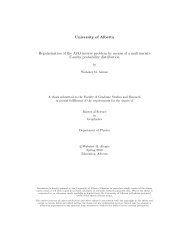Soner Bekleric Title of Thesis: Nonlinear Prediction via Volterra Ser
Soner Bekleric Title of Thesis: Nonlinear Prediction via Volterra Ser
Soner Bekleric Title of Thesis: Nonlinear Prediction via Volterra Ser
Create successful ePaper yourself
Turn your PDF publications into a flip-book with our unique Google optimized e-Paper software.
5.1. INTRODUCTION 76<br />
ples remains as a problem in exploration seismology. In this Chapter, I present the<br />
adaptive subtraction methods based on <strong>Volterra</strong> series that can be used to attenuate<br />
the multiples.<br />
In the adaptive multiple subtraction problem, one has access to a distorted<br />
version <strong>of</strong> the multiples and the goal is to find an operator that eliminates the<br />
distortion before subtracting them from the data. There are many methods to<br />
annihilate multiple reflections such as inverse scattering and surface-related multiple<br />
attenuation (SRME) (autoconvolution in space) (Weglein et al., 1992; Verschuur<br />
et al., 1992; Berkhout and Verschuur, 1997; Spitz, 1999; Abma et al., 2005). I am<br />
not going to explain here how a multiple model can be produced; this subject is well<br />
understood and published in many studies (Verschuur et al., 1992; Weglein et al.,<br />
1992; Berkhout and Verschuur, 1997; Verschuur and Berkhout, 1997; Verschuur and<br />
Prein, 1999; Weglein, 1999). These methods are used to construct multiple models,<br />
which are subsequently utilized by adaptive subtraction algorithms.<br />
In this thesis I introduce a method for adaptive subtraction <strong>of</strong> multiples, using<br />
a f − x linear prediction filter. A nonlinear prediction filter based on a <strong>Volterra</strong><br />
series for the removal <strong>of</strong> multiples from recorded data sets. The problem can also<br />
be tackled using linear prediction error filters in the f − x domain as suggested<br />
by Spitz (1999). The idea is to compute a f − x prediction error operator from<br />
the estimate <strong>of</strong> the multiples. Then, the estimated prediction error filter is applied<br />
to the data containing both primaries and multiples to annihilate the multiples.<br />
The procedure is equivalent to finding a notch filter with the notch positioned at<br />
the wave number representing the multiple. The procedure <strong>of</strong> Spitz (1999) can fail<br />
when the multiple events in the window <strong>of</strong> analysis cannot be modeled as linear









